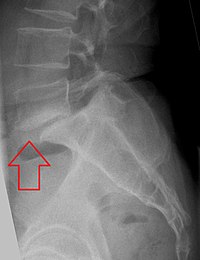
Photo from wikipedia
Study Design: Retrospective review. Objectives: To evaluate the rate of nonoperative treatment failure for cervical facet fractures while secondarily validating computed tomography–based criteria proposed by Spector et al for identifying… Click to show full abstract
Study Design: Retrospective review. Objectives: To evaluate the rate of nonoperative treatment failure for cervical facet fractures while secondarily validating computed tomography–based criteria proposed by Spector et al for identifying risk of failure of nonoperative management. Methods: Single-level or multilevel unilateral cervical facet fractures from 2007 to 2014 were included. Exclusion criteria included spondylolisthesis, dislocated or perched facets, bilateral facet fractures at the same level, floating lateral mass, thoracic or lumbar spine injuries, or spinal cord injury. Patients were placed into 3 groups for evaluation: immediate operative management, successful nonoperative management, and failed nonoperative treatment requiring surgical intervention. Results: Eighty-eight patients (106 facets) were included. Twenty-one patients underwent operative treatment with anterior cervical discectomy and fusion or posterior spinal instrumentation and fusion without any failures. Sixty-seven of these patients were treated nonoperatively with either a hard collar (n = 62) or halo vest (n = 5). Eleven patients failed nonoperative treatment (16.4%), all with an absolute fracture height of at least 1 cm and 40% involvement of the absolute height of the lateral mass. Of the 56 patients successfully treated through nonoperative measures, 8 (14.3%) had fracture measurements exceeding both operative parameters. Conclusion: We conclude that it is safe and appropriate for patients with unilateral cervical facet fractures to receive a trial period of nonoperative management. However, patients who weigh over 100 kg, have comminuted fractures, or have radiographic measurements outside of the proposed computed tomography criteria for nonoperative treatment should be educated on the risks of treatment failure.
Journal Title: Global Spine Journal
Year Published: 2019
Link to full text (if available)
Share on Social Media: Sign Up to like & get
recommendations!